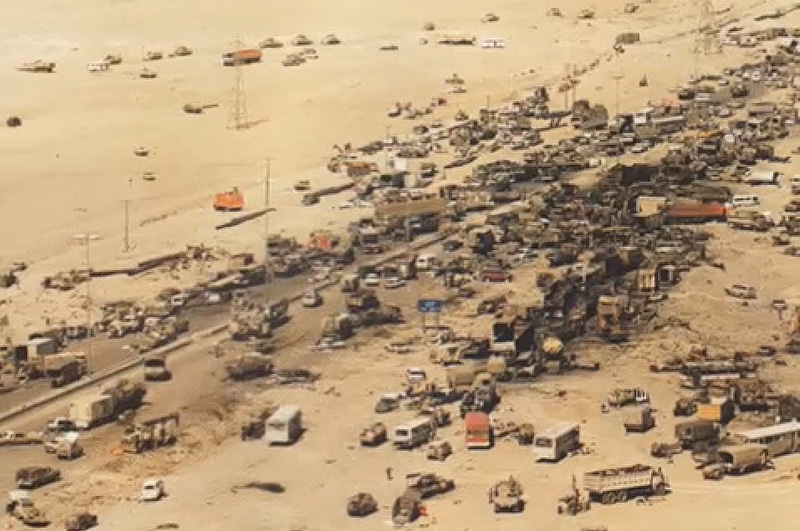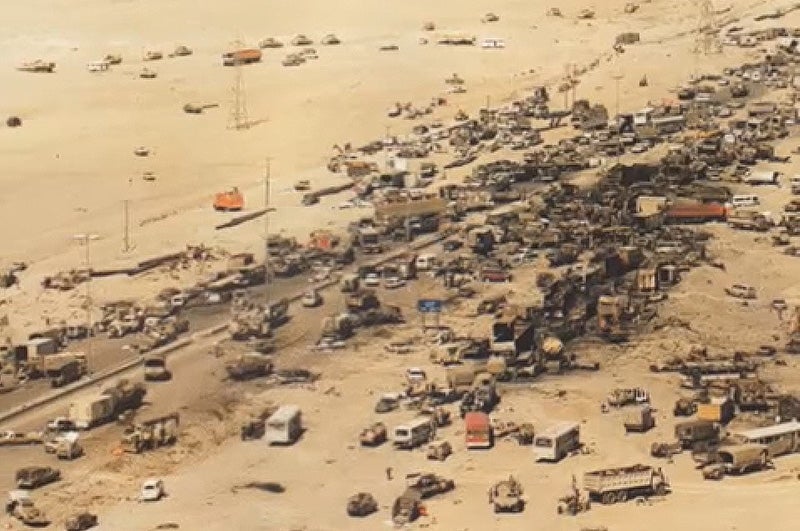
Highway 80 was a six lane highway leading across the desert from Basra, Iraq to Kuwait City. It was one of the main highways that gave Iraq quick access into Kuwait during their invasion of the country, but their return trip would be much less triumphant and horrifically deadly.
On the night of February 26th, 1991, after over a month of heavy bombardment and facing the full onslaught of advancing coalition grand forces, thousands of Iraqi military personnel and vehicles, as well as a sea of stolen Kuwaiti cars packed with looted valuables, attempted to retreat from Kuwait. At the time, Iraq had announced that it would withdraw, but it had not accepted the UN resolutions passed against them.
Advertisement
There were not many route options that ran between Iraq and Kuwait to stage a large-scale military retreat. As a result, a massive amount of Saddam’s forces deployed months earlier to seize Kuwait were now crowded along the few highways that lead out of the country and into Iraq—the main one being Highway 80.
Intelligence on the ground in Kuwait reported that the Iraqis were packing up, but no hard actionable intelligence could be had for targeting the retreating force. Kuwaiti intelligence advisers told U.S. commanders that their their countrymen would not be among the traffic leaving, and that the coalition should engage freely.
Sponsored
Then one of America’s newest super-weapons, the E-8 Joint Surveillance and Targeting Radar System (J-STARS)—made to detect and track moving vehicles on the ground—reported something unusual. What appeared on their radar scopes seemed to be a huge convoy traveling north, leaving Kuwait City and heading toward Kuwait’s northern border with Iraq.
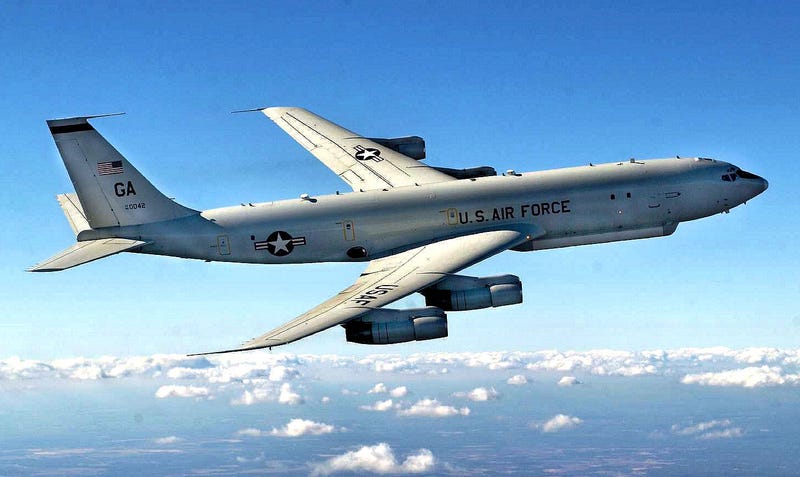
All available aerial attack assets were vectored towards the huge three mile long convoy of armor, trucks, buses and stolen civilian vehicles. The weather was an issue at the time, and visibility was made worse by the hundreds of oil well fires set by Saddam’s military during the war.
USMC A-6E Intruders that were patrolling the Kuwaiti coastline were first on the scene and armed ideally for the grim job at hand. The jets were carrying Mark 20 Rockeye cluster munitions which could rain devastation over a fairly wide area. The Intruders aimed at the front and rear of the convoy. If the munitions landed correctly, the tactic would trap all the remaining vehicles in between burning vehicles and cratered sections of highway on both ends of the convoy. In effect, it would turn the roughly four mile stretch of road into a bombing range.
The cluster munitions did their job. Both ends of escape were cut off, and vehicles at the head of the convoy careened into one another if they were not destroyed by the crescendo of sub-munitions.
What happened next remains highly controversial to this day. Wave after wave of coalition aircraft had their turn attacking the trapped vehicles. Flights of A-10 Warthogs were especially deadly, flying below the weather and expending all their munitions and cannon ammunition during multiple attack runs. The stretch of highway was worked over by coalition aircraft for 10 straight hours. Aboard carriers in the Gulf, any munitions ready for loading were being ordered onto fighter and attack jets with haste. Many of the vehicles that attempted to flee by driving off the highway were hunted down and destroyed.
It was a feeding frenzy.
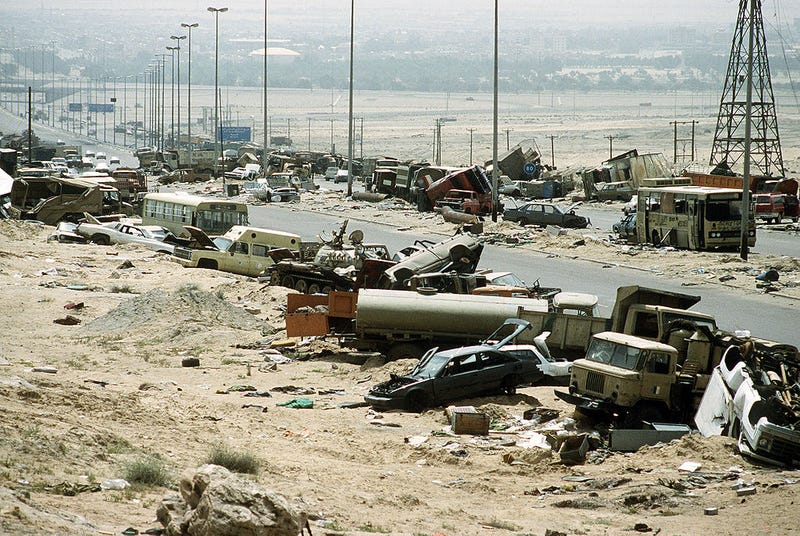
Stripes.com reports that an A-10 Warthog pilot involved in the attacks that night told the following to reporters:
“There’s just nothing like it. It’s the biggest Fourth of July show you’ve ever seen, and to see those tanks just go ‘boom,’ and more stuff just keep spewing out of them and shells flying out to the ground, they just became white hot. It’s wonderful.”
Not too far to the east, Highway 8 near the Kuwaiti coastline was also becoming the scene of a carnage. Iraqi Republican Guard units were trying to escape via the route, although not in such a concentrated way as the group on Highway 80. Along a 30 mile stretch of the road, US Army AH-64 Apache helicopters and artillery made the road their killing field. Hundreds of vehicles, including some of Hussein’s best tanks and armored personnel carriers, were pummeled into unrecognizable heaps of mangled steel.
The next morning, both roadways looked like something out of a horror movie. It was absolute and total destruction. Burnt vehicles and charred corpses littered the landscape.
In all, at least many hundreds but possibly thousands of Iraqis were killed during the coalition onslaught, and thousands of vehicles were destroyed as well.
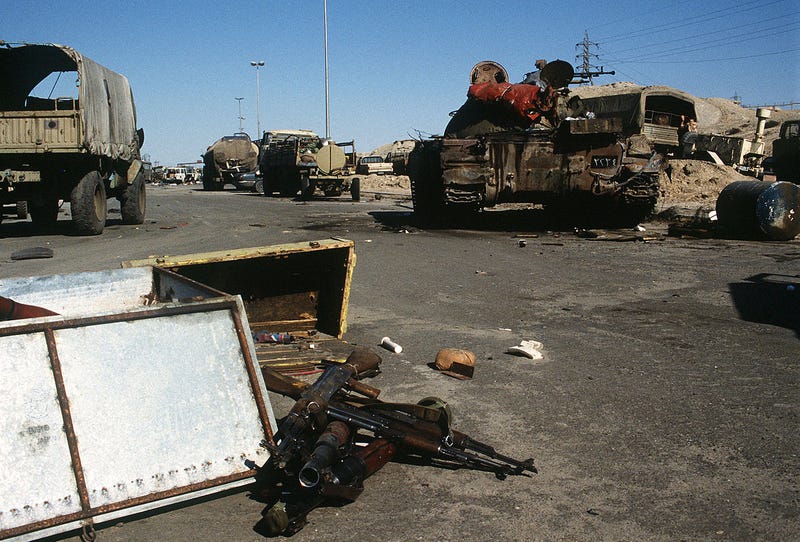
Images from this military action were by far the most gruesome of Desert Storm. Although commanders state that the assault was justworthy in order to neuter Hussein’s war-fighting capabilities, many others have called it a massacre.
It is clear that Iraqi forces were retreating from Kuwait, as UN resolution 660 demanded, but Saddam Hussein had not capitulated defeat just yet. General Norman Schwarzkopf stated the following about the Highway of Death four years after it occurred:
“The first reason why we bombed the highway coming north out of Kuwait is because there was a great deal of military equipment on that highway, and I had given orders to all my commanders that I wanted every piece of Iraqi equipment that we possibly could destroy. Secondly, this was not a bunch of innocent people just trying to make their way back across the border to Iraq. This was a bunch of rapists, murderers and thugs who had raped and pillaged downtown Kuwait City and now were trying to get out of the country before they were caught.”
It is widely known that imagery of the carnage that occurred on the “Highway of Death” was a major factor in the Bush Administration ending combat operations the next day, while Hussein was still in power. Today the event remains one of the most powerful examples of time-sensitive targeting and the rapid application of air power. It also remains one of the bloodiest moments in modern warfare that some would argue was not justified.
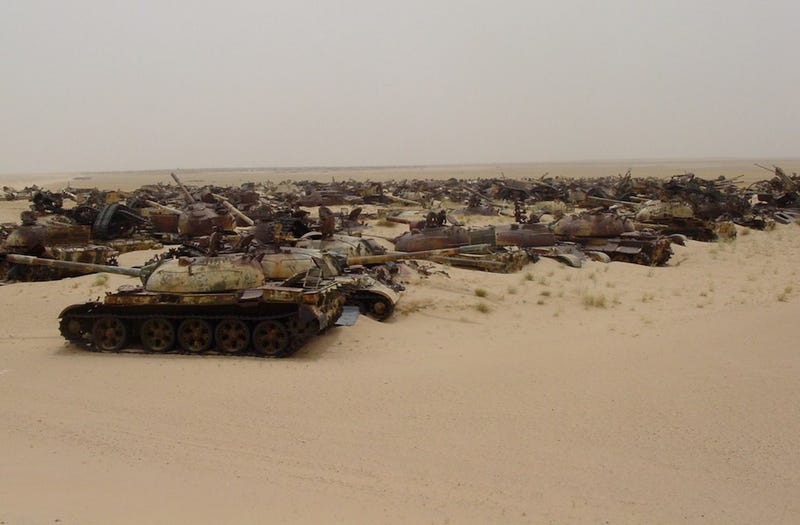
Top shot via screen-cap, E-8 photo via UDAF, all other photos via AP
Contact the author at Tyler@jalopnik.com.

